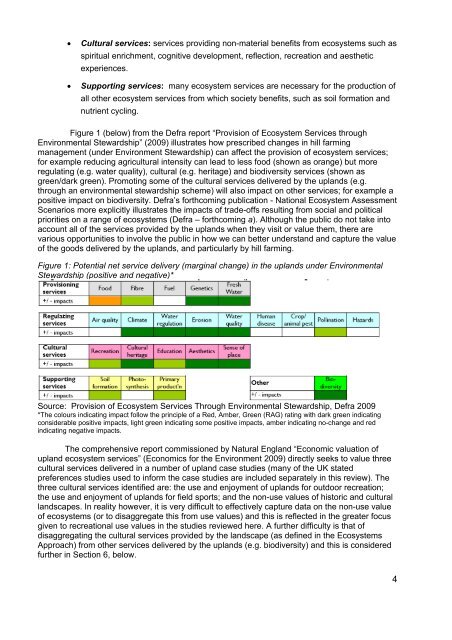Public Attitudes and Preferences for Upland Landscapes - Defra
Public Attitudes and Preferences for Upland Landscapes - Defra
Public Attitudes and Preferences for Upland Landscapes - Defra
You also want an ePaper? Increase the reach of your titles
YUMPU automatically turns print PDFs into web optimized ePapers that Google loves.
• Cultural services: services providing non-material benefits from ecosystems such as<br />
spiritual enrichment, cognitive development, reflection, recreation <strong>and</strong> aesthetic<br />
experiences.<br />
• Supporting services: many ecosystem services are necessary <strong>for</strong> the production of<br />
all other ecosystem services from which society benefits, such as soil <strong>for</strong>mation <strong>and</strong><br />
nutrient cycling.<br />
Figure 1 (below) from the <strong>Defra</strong> report “Provision of Ecosystem Services through<br />
Environmental Stewardship” (2009) illustrates how prescribed changes in hill farming<br />
management (under Environment Stewardship) can affect the provision of ecosystem services;<br />
<strong>for</strong> example reducing agricultural intensity can lead to less food (shown as orange) but more<br />
regulating (e.g. water quality), cultural (e.g. heritage) <strong>and</strong> biodiversity services (shown as<br />
green/dark green). Promoting some of the cultural services delivered by the upl<strong>and</strong>s (e.g.<br />
through an environmental stewardship scheme) will also impact on other services; <strong>for</strong> example a<br />
positive impact on biodiversity. <strong>Defra</strong>’s <strong>for</strong>thcoming publication - National Ecosystem Assessment<br />
Scenarios more explicitly illustrates the impacts of trade-offs resulting from social <strong>and</strong> political<br />
priorities on a range of ecosystems (<strong>Defra</strong> – <strong>for</strong>thcoming a). Although the public do not take into<br />
account all of the services provided by the upl<strong>and</strong>s when they visit or value them, there are<br />
various opportunities to involve the public in how we can better underst<strong>and</strong> <strong>and</strong> capture the value<br />
of the goods delivered by the upl<strong>and</strong>s, <strong>and</strong> particularly by hill farming.<br />
Figure 1: Potential net service delivery (marginal change) in the upl<strong>and</strong>s under Environmental<br />
Stewardship (positive <strong>and</strong> negative)*<br />
Source: Provision of Ecosystem Services Through Environmental Stewardship, <strong>Defra</strong> 2009<br />
*The colours indicating impact follow the principle of a Red, Amber, Green (RAG) rating with dark green indicating<br />
considerable positive impacts, light green indicating some positive impacts, amber indicating no-change <strong>and</strong> red<br />
indicating negative impacts.<br />
The comprehensive report commissioned by Natural Engl<strong>and</strong> “Economic valuation of<br />
upl<strong>and</strong> ecosystem services” (Economics <strong>for</strong> the Environment 2009) directly seeks to value three<br />
cultural services delivered in a number of upl<strong>and</strong> case studies (many of the UK stated<br />
preferences studies used to in<strong>for</strong>m the case studies are included separately in this review). The<br />
three cultural services identified are: the use <strong>and</strong> enjoyment of upl<strong>and</strong>s <strong>for</strong> outdoor recreation;<br />
the use <strong>and</strong> enjoyment of upl<strong>and</strong>s <strong>for</strong> field sports; <strong>and</strong> the non-use values of historic <strong>and</strong> cultural<br />
l<strong>and</strong>scapes. In reality however, it is very difficult to effectively capture data on the non-use value<br />
of ecosystems (or to disaggregate this from use values) <strong>and</strong> this is reflected in the greater focus<br />
given to recreational use values in the studies reviewed here. A further difficulty is that of<br />
disaggregating the cultural services provided by the l<strong>and</strong>scape (as defined in the Ecosystems<br />
Approach) from other services delivered by the upl<strong>and</strong>s (e.g. biodiversity) <strong>and</strong> this is considered<br />
further in Section 6, below.<br />
4
















